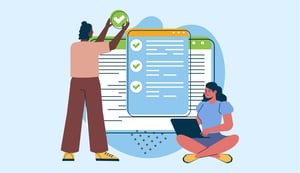As a B2B SaaS founder or marketer, you understand the importance of user onboarding.
After all, first impressions matter, and a positive user onboarding experience can make all the difference in retaining users and building a loyal customer base.
One essential tool in creating an effective user onboarding process is the user onboarding survey. However, it's hard to strike a balance between collecting valuable feedback and making sure your survey doesn't put users to sleep.
How do you ask the right questions, in the right way, to get the insights you need? In this blog post, we will explore how to create a good user onboarding survey for your SaaS, helping you to better understand your users and improve your onboarding experience.
What Is a User Onboarding Survey?
A user onboarding survey is a feedback tool used by companies to assess how well their onboarding process is working for new users. It typically includes a series of questions that aim to capture the user's experience during the onboarding process, including their first impressions of the product, their ease of use, and their overall satisfaction with the experience.
The survey can be conducted in various formats, such as online forms, in-app pop-ups, or email surveys, and can be delivered at different stages of the onboarding process. They provide a unique opportunity to learn more about the person or business that signed up and match those insights with the product information.
3 Things to Keep in Mind While Creating a User Onboarding Survey
1. Gauge User Sentiment With Quantitative Questions
When it comes to creating a good user onboarding survey for SaaS, it's important to gauge user sentiment with quantitative questions. This involves using questions that can be measured numerically to obtain specific feedback about the user's experience with your SaaS product.
For example, you could use a Likert scale question, which allows users to rate their experience on a scale of 1 to 5 or 1 to 10. This type of question is useful for gathering quantitative data about user satisfaction, usability, and overall experience with your product. Some examples of Likert scale questions that could be used in a user onboarding survey for SaaS include:
- How satisfied are you with the onboarding process?
- How easy was it to set up your account?
- How likely are you to recommend our product to a friend or colleague?
Another quantitative question type that can be used in a user onboarding survey is a multiple-choice question. This type of question allows users to select one or more options from a list of predetermined answers. Multiple-choice questions can be used to gather specific feedback about certain aspects of your SaaS product or onboarding process. Examples of multiple-choice questions that could be used in a user onboarding survey for SaaS include:
- Which of the following best describes your experience with our product so far?
- Which of the following features did you find most helpful during onboarding?
- Which of the following words would you use to describe your experience with our product?
Overall, using quantitative questions in your user onboarding survey can help you gather specific feedback from your users, which can be used to improve your product and create a better overall user experience. Just be sure to use friendly language and a conversational tone to make users feel comfortable and encourage them to provide honest feedback.
2. Gain More Context With Qualitative Questions
In addition to using quantitative questions to gauge user sentiment in your user onboarding survey for SaaS, it's also important to gain more context with qualitative questions. Qualitative questions allow users to provide more detailed, open-ended feedback about their experience, which can provide valuable insights into how users are interacting with your product and where improvements can be made.
Examples of qualitative questions that could be used in a user onboarding survey for SaaS include:
- What was the most confusing or frustrating aspect of the onboarding process?
- Can you describe a time when you felt stuck or unsure how to proceed during onboarding?
- What feature or aspect of our product could be improved to better meet your needs?
Open-ended questions like these allow users to share their experiences and provide feedback in their own words, which can be especially helpful for identifying specific pain points or areas for improvement. However, it's important to note that analyzing and categorizing the data from qualitative questions can be more time-consuming and complex than analyzing quantitative data.
To make it easier to analyze and interpret qualitative data, consider using a structured format for your open-ended questions. For example, you could ask users to complete the sentence "I wish the product could..." or "The thing I like most about the product is...", which can help users provide more focused and specific feedback. Additionally, consider using follow-up questions to clarify or expand upon users' responses to qualitative questions, which can provide even more context and insights into their experiences. You can consider using a conditional form builder to ask specific follow-up questions based on the user's answer to the previous question.
Overall, using both quantitative and qualitative questions in your user onboarding survey for SaaS can help you gather a more complete picture of user sentiment and experience, which can be used to improve your product and create a better overall user experience.
3. Avoid Biased or Vague Questions
When creating a user onboarding survey for SaaS, it's important to avoid biased, vague, or loaded questions that could lead to inaccurate or unreliable data. These types of questions can make it difficult to interpret or analyze the results of the survey, and can also lead to biased or misleading conclusions.
Biased questions are those that are worded in a way that leads users towards a certain answer or point of view. For example, a question like "Don't you agree that our product is the best on the market?" is clearly biased, as it assumes that the user agrees with the statement. To avoid biased questions, try to use neutral language and avoid making assumptions about what users think or feel.
Vague questions are those that are unclear or ambiguous, making it difficult for users to understand what is being asked. For example, a question like "How do you feel about the product?" is vague, as it doesn't specify what aspect of the product the user should be evaluating. To avoid vague questions, be specific and clear in your wording, and provide context or examples where necessary.
Loaded questions are those that include assumptions or opinions that are not necessarily shared by all users. For example, a question like "Don't you think our product is too expensive?" is loaded, as it assumes that all users share the opinion that the product is expensive. To avoid loaded questions, use neutral language and avoid making assumptions about what users think or feel.
To ensure that your user onboarding survey for SaaS is effective and reliable, make sure to review your questions carefully and consider how they might be perceived by users. Consider testing your survey with a small group of users before sending it out more widely, and be open to feedback and suggestions for improvement.
Sample Questions for Onboarding Surveys
Here are fifteen sample questions for an onboarding survey relevant to a B2B SaaS company selling:
1. General questions:
- How did you hear about our product?
- Why did you decide to sign up for our product?
- Have you used similar products before?
2. User experience questions:
- How easy was it to sign up for our product?
- How intuitive did you find our product?
- Did you encounter any issues during the onboarding process?
3. Product feature questions:
- Have you explored all of our product's features?
- Which product features are most important to you?
- Do you feel like our product meets your business needs?
4. Customer support questions:
- How would you rate our customer support during the onboarding process?
- Was there anything missing from our customer support during the onboarding process?
- Have you contacted our customer support since signing up for our product?
5. Overall satisfaction questions:
- How satisfied are you with our product overall?
- How likely are you to recommend our product to others?
- Is there anything we could have done differently during the onboarding process to improve your experience?
The goal is to keep the survey short and focused. You can adjust the questions to suit your specific product and business needs, but the categories above can serve as a starting point.
Final Thoughts
Are you struggling to create an effective onboarding experience for your SaaS product? Do you find yourself spending countless hours writing emails and in-app notifications to teach users how to use your product?
Then you should talk to us. We at Inturact specializes in user onboarding services. We help you create a seamless onboarding experience for your users, from writing emails to implementing them and tracking their effectiveness. With our expert guidance and support, you can rest assured that your users will have the best possible experience when they first interact with your product. Let's chat more? Click here.



